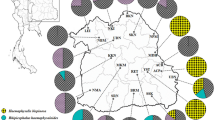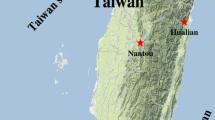Abstract
The genetic identity of Ixodes granulatus ticks was determined for the first time in Taiwan. The phylogenetic relationships were analyzed by comparing the sequences of mitochondrial 16S ribosomal DNA gene obtained from 19 strains of ticks representing seven species of Ixodes and two outgroup species (Rhipicephalus sanguineus and Haemaphysalis inermis). Four major clades could be easily distinguished by neighbour-joining analysis and were congruent by maximum-parsimony method. All these I. granulatus ticks of Taiwan were genetically affiliated to a monophyletic group with highly homogeneous sequences (92.2–99.3% similarity), and can be discriminated from other Ixodes species and other genera of ticks with a sequence divergence ranging from 11.7 to 30.8%. Moreover, intraspecific analysis revealed that two distinct lineages are evident between the same species of I. granulatus ticks collected from Taiwan and Malaysia. Our results demonstrate that all these I. granulatus ticks of Taiwan represent a unique lineage distinct from the common vector ticks (I. ricinus complex) for Borrelia burgdorferi spirochetes.





Similar content being viewed by others
References
Aguero-Rosenfeld ME, Wang GQ, Schwartz I et al (2005) Diagnosis of Lyme borreliosis. Clin Microbiol Rev 18:484–509
Ai CX, Wen YX, Zhang YG et al (1988) Clinical manifestations and epidemiological characteristics of Lyme disease in Hailin county, Heilongjiang Province, China. Annals NY Acad Sci 539:302–313
Balashov YS (1972) Bloodsucking ticks (Ixodoidea)-vectors of diseases of man and animals. Misc Publ Entomol Soc Am 8:268–305
Black WC IV, Piesman J (1994) Phylogeny of hard- and soft-tick taxa (Acari: Ixodida) based on mitochondrial 16S ribosomal DNA sequences. Proc Natl Acad Sci USA 91:10034–10038
Black WC IV, Roehrdanz RL (1998) Mitochondrial gene order is not conserved in arthropods: prostriate and metastriate tick mitochondrial genomes. Mol Biol Evol 15:1772–1785
Burgdorfer W, Barbour AGS, Hayes FW et al (1982) Lyme disease: a tick-borne spirochetosis? Science 216:1317–1319
Campbell NJH, Barker SC (1999) The novel mitochondrial gene arrangement of the cattle tick, Boophilus microplus: fivefold tandem repetition of a coding region. Mol Biol Evol 16:732–740
Caporale DA, Rich SM, Spielman A et al (1995) Discriminating between Ixodes ticks by means of mitochondrial DNA sequences. Mol Phylogenet Evol 4:361–365
Chigagure NN, Baxter GD, Barker SC (2000) Microsatellite loci of the cattle tick Boophilus microplus (Acari: Ixodidae). Exp Appl Acarol 24:951–956
Crosbie PR, Boyce WM, Rodwell TC (1998) DNA sequence variation in Dermacentor hunteri and estimated phylogenies of Dermacentor spp. (Acari: Ixodidae) in the New World. J Med Entomol 35:277–288
Felsenstein J (1985) Confidence limits on phylogenies: an approach using the bootstrap. Evolution 52:1119–1134
Johnson RC, Schmid GP, Hyde FW et al (1984) Borrelia burgdorferi sp. nov.: etiological agent of Lyme disease. Int J Syst Bacteriol 34:496–497
Kain DE, Sperling FA, Daly HV et al (1999) Mitochondrial DNA sequence variation in Ixodes pacificus (Acari: Ixodidae). Heredity 83:378–386
Kawabata M, Baba S, Iguchi K et al (1987) Lyme disease in Japan and its possible incriminated tick vector, Ixodes persulcatus. J Infect Dis 156:854
Keirans JE, Clifford CM (1978) The genus Ixodes in the United States: a scanning electron microscope study and key to the adults. J Med Entomol Suppl. 2:1–149
Kimura M (1980) A simple method for estimating evolutionary rate of base substitutions through comparative studies of nucleotide sequences. J Mol Evol 16:111–120
Kumar S, Tamura K, Nei M (2004) MEGA 3: integrated software for molecular evolutionary genetics analysis and sequence alignment. Briefings in Bioinform 5:150–163
Kurtenbach K, De Michelis S, Etti S et al (2002) Host associations of Borrelia burgdorferi sensu lato-the key role of host complement. Trends in Microbiol 10:74–79
Matuschka FR, Richter D, Fischer P et al (1990) Subadult Ixodes ricinus (Acari: Ixodidae) on rodents in Berlin, West Germany. J Med Entomol 27:385–390
Maupin GO, Gage KL, Piesman J et al (1994) Discovery of an enzootic cycle of Borrelia burgdorferi in Neotoma mexicana and Ixodes spinipalpis from northern Colorado, an area where Lyme disease is nonendemic. J Infect Dis 170:636–643
Murrell A, Campbell NJH, Barker SC (2000) Phylogenetic analysis of the Rhipicephaline ticks indicate that the genus Rhipicephalus is paraphyletic. Mol Phylogen Evol 16:1–7
Nakao M, Miyamoto K, Uchikawa K et al (1992) Characterization of Borrelia burgdorferi isolated from Ixodes persulcatus and Ixodes ovatus ticks in Japan. Am J Trop Med Hyg 47:505–511
Norris DE, Klompen JSH, Keirans JE et al (1996) Population genetics of Ixodes scapularis (Acari: Ixodidae) based on mitochondrial 16S and 12S genes. J Med Entomol 33:78–89
Oliver JH, Owsley MR, Hutcheson HJ et al (1993) Conspecificity of the ticks Ixodes scapularis and I. dammini (Acari: Ixodidae). J Med Entomol 30:54–63
Peavey CA, Lane RS, Damrow T (2000) Vector competence of Ixodes angustus (Acari: Ixodidae) for Borrelia burgdorferi sensu stricto. Exp Appl Acarol 24:77–84
Rich SM, Caporale DA, Telford SR III et al (1995) Distribution of the Ixodes ricinus-like ticks of eastern North America. Proc Nat Acad Sci 92:6284–6288
Robbins RG (2005) The ticks (Acari: Ixodida: Argasidae, Ixodidae) of Taiwan: a synonymic checklist. Proc Entomol Soci Wash 107:245–253
Schmid GP (1985) The global distribution of Lyme disease. Rev Infect Dis 7:41–50
Shih CM, Chao LL (1998) Lyme disease in Taiwan: primary isolation of Borrelia burgdorferi-like spirochetes from rodents in Taiwan area. Am J Trop Med Hyg 59:687–692
Shih CM, Chao LL (2002) Genetic analysis of the outer surface protein C of Lyme disease spirochetes (Borrelia burgdorferi sensu lato) isolated from rodents in Taiwan. J Med Microbiol 51:318–325
Shih CM, Chao LL (2004) Current status of Lyme disease in Taiwan with description of its vector ticks and reservoir hosts. In: Lu KH et al (eds) Proceedings, Symposium on rodent damage and control strategy. The Plant Protection Society of the Republic of China, Taichung, Taiwan, pp 79–92 (in Chinese)
Shih CM, Liu LP, Chung WC et al (1997) Human babesiosis in Taiwan: asymptomatic infection with a Babesia microti-like organism in a Taiwanese woman. J Clin Microbiol 35:450–454
Shih CM, Chang HM, Chen SL et al (1998a) Genospecies identification and characterization of Lyme disease spirochetes of genospecies Borrelia burgdorferi sensu lato isolated from rodents in Taiwan. J Clin Microbiol 36:3127–3132
Shih CM, Wang JC, Chao LL et al (1998b) Lyme disease in Taiwan: first human patient with characteristic erythema chronicum migrans skin lesion. J Clin Microbiol 36:807–808
Shih CM, Chao LL, Yu CP (2002) Chemotactic migration of the Lyme disease spirochete (Borrelia burgdorferi) to salivary gland extracts of vector ticks. Am J Trop Med Hyg 66:616–621
Smith T, Kilbourne FL (1893) Investigation into the nature, causation, and prevention of Texas or Southern Cattle fever. Bureau of Animal Industries, Bull No. 1 U.S. Department of Agriculture, Washington, DC
Sonenshine DE (1991) Biology of ticks. Oxford University Press, New York
Spielman A (1988) Lyme disease and human babesiosis: evidence incriminating vector and reservoir hosts. In: Englund PT, Sher AR (eds) The biology of parasitism. Liss, New York, pp 147–165
Spielman A, Clifford CM, Piesman J et al (1979) Human babesiosis on Nantucket Island, USA: description of the vector, Ixodes (Ixodes) dammini, n. sp. (Acarina: Ixodidae). J Med Entomol 15:218–234
Steere AC (2001) Lyme disease. New Engl J Med 345:115–125
Teng KF, Jiang ZJ (1991) Economic insect fauna of China Fasc 39 Acari: Ixodidae. Science Press, Beijing (in Chinese)
Thompson JD, Higgins DG, Gibson TJ (1994) CLUSTAL W: imaproving the sensitivity of progressive multiple sequence alignment through sequence weighting, position-specific gap penalties and weight matrix choice. Nuc Acids Res 22:4673–4680
Wan KL, Zhang ZF, Dou GL et al (1998) Investigation on primary vectors of Borrelia burgdorferi in China. Chinese J Epidemiol 19:263–266 (in Chinese)
Wilson N (1970) New distributional records of ticks from Southeast Asia and the Pacific (Metastigmata: Argasidae, Ixodidae). Oriental Insects 4:37–46
Xu G, Fang QQ, Keirans JE et al (2003) Molecular phylogenetic analysis indicate that the Ixodes ricinus complex is a paraphyletic group. J Parasit 89:452–457
Zhang ZF, Wan KL, Zhang JS et al (1997) Studies on epidemiology and etiology of Lyme disease in China. Chinese J Epidemiol 18:8–11 (in Chinese)
Acknowledgments
This work was supported in part by a grant from the National Science Council (NSC96-2314-B-016-025-MY3), Taipei, Taiwan, Republic of China.
Author information
Authors and Affiliations
Corresponding author
Rights and permissions
About this article
Cite this article
Chao, LL., Wu, WJ. & Shih, CM. Molecular analysis of Ixodes granulatus, a possible vector tick for Borrelia burgdorferi sensu lato in Taiwan. Exp Appl Acarol 48, 329–344 (2009). https://doi.org/10.1007/s10493-009-9244-4
Received:
Accepted:
Published:
Issue Date:
DOI: https://doi.org/10.1007/s10493-009-9244-4




